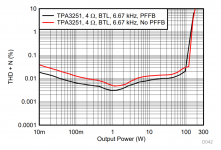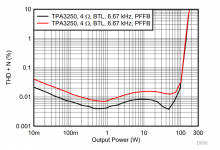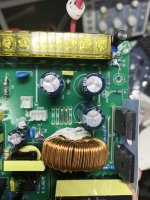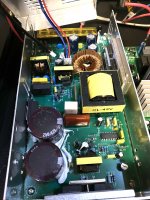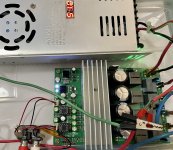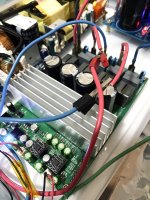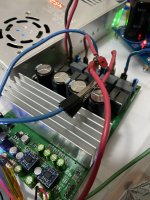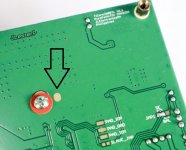D
Deleted member 148505
+1
Same results here: depending on personal taste
1/ Non PFFB (TPA3255EVM opamps bypassed)
2/ With PFFB (drMordor TPA3255)
Nice job ...
Enjoy
Thank you
I provided a solder jumper under the PCB on my TPA3255 modules so that we can disable PFFB. So that the owner can choose what he prefers.
-------------------------
Also after continuous listening on OPA1656 input opamps, I found them sterile sounding for my taste, it is realistic sounding but it removes the 'bloom' sound. So instead, I will offer LME49860MAX/NOPB for options C and D.
I provided a solder jumper under the PCB on my TPA3255 modules so that we can disable PFFB. So that the owner can choose what he prefers.
-------------------------
Also after continuous listening on OPA1656 input opamps, I found them sterile sounding for my taste, it is realistic sounding but it removes the 'bloom' sound. So instead, I will offer LME49860MAX/NOPB for options C and D.
Good idea for the jumper Lester !
And I have the same feeling with OPA1656 when I listen them with my Toneking 9way IEM...
LME49860 is the best choice !

D
Deleted member 148505
Good idea for the jumper Lester !
And I have the same feeling with OPA1656 when I listen them with my Toneking 9way IEM...
LME49860 is the best choice !
I will be able to hear it once my order of LME49860 arrives
Also I understand that the high output power of 48V~53V TPA3255 is one of its strengths. It has a huge dynamic headroom which means that it will be hard for us to reach the clipping point when we are listening to music in our homes. (unless we do party level loud music). Also if I want to upgrade speakers in the future, TPA3255 48V can handle most of them.
If ppppp or someone has a low wattage, high sensitivity speaker, 36V PFFB is also good if he wants lower THD.
I checked the THD levels of TPA3251 and TPA3250 PFFB configuration in SLAA788A, TPA3251 uses 7uH inductors so it should be better, it has less THD on 1kHz at 1W to 10W.
But on 6.67kHz it has some wins in the plot but not that much, also has rising THD levels on 10W to 100W unlike the TPA3250, so TPA3250 PFFB configuration is also good even though it uses 10uH inductors. TPA3250 6.67kHz THD+N hovers under 0.01% up to 80W unlike TPA3251 which crosses 0.01% after 40W
Attachments
Last edited by a moderator:
Heatsink is the same as the one used in TPA3255 EVM (attached pic), you just need a high performance thermal compound. I am including compatible screws for the heatsink in Options A and B.
Hi Lester, what are the physical LxW measurements of the new PFFB board? It’s got to be bigger than the non-PFFB amp.
Thanks, Pete
This is what is specified in his online shop
Footprint: 148mm x 100mm x 40mm (L * W * H)
Thanks commstech.
Pete
D
Deleted member 148505
2nd pic) I opened the generic 600W adjustable SMPS to disconnect the noisy howling fan. Mains side caps looks second hand, yuck haha.
1st pic) Output caps are 3pc 1000uF 50V (blue caps on pic).
Since the voltage can be adjusted from 1.5V to 51.6V (which is amazing), the caps might get damaged sooner or later so I replaced them with Lelon 1200uF 63V.
3rd pic) Currently listening to LME49860MAX/NOPB, initial impression: sound is more like an improvement of LME49720NA. Better bass, thicker sounding mids, thicker and more forward voices, highs are almost the same as 49720. Less treble than LM4562NA.
1st pic) Output caps are 3pc 1000uF 50V (blue caps on pic).
Since the voltage can be adjusted from 1.5V to 51.6V (which is amazing), the caps might get damaged sooner or later so I replaced them with Lelon 1200uF 63V.
3rd pic) Currently listening to LME49860MAX/NOPB, initial impression: sound is more like an improvement of LME49720NA. Better bass, thicker sounding mids, thicker and more forward voices, highs are almost the same as 49720. Less treble than LM4562NA.
Attachments
Last edited by a moderator:
JLesterP,
I received the board. Appreciate the very good packing to protect the board. I have 3 questions here:
1.To disable PFFB, simply remove the solder bridge at RF1,2,3 and 4?
2.Solder bridge SJ1,2,3 and 4 – may I know what are these for?
3.The placement of the 2 x red insulating washers provided is between the board and heatsink when using the 2 x screws to secure the heatsink?
Thank you for your help so far, and the very nice quality board.
I received the board. Appreciate the very good packing to protect the board. I have 3 questions here:
1.To disable PFFB, simply remove the solder bridge at RF1,2,3 and 4?
2.Solder bridge SJ1,2,3 and 4 – may I know what are these for?
3.The placement of the 2 x red insulating washers provided is between the board and heatsink when using the 2 x screws to secure the heatsink?
Thank you for your help so far, and the very nice quality board.
D
Deleted member 148505
JLesterP,
I received the board. Appreciate the very good packing to protect the board. I have 3 questions here:
1.To disable PFFB, simply remove the solder bridge at RF1,2,3 and 4?
2.Solder bridge SJ1,2,3 and 4 – may I know what are these for?
3.The placement of the 2 x red insulating washers provided is between the board and heatsink when using the 2 x screws to secure the heatsink?
Thank you for your help so far, and the very nice quality board.
Nice! Thanks and enjoy your new amp.
For 1 and 2) I've put solder bridge s(RF1, RF2, RF3, RF4) on the output side, and solder bridges on the input side (SJ1, SJ2, SJ3, SJ4).
If you just want to disable PFFB temporarily to check for non-pffb sound, remove solder bridge on SJ1 to SJ4.
3. Placement of red insulating washers is under the PCB so that it will hold the screws in place. Because the head of the screw is small compared to the hole on the board.
Do you already have the parts onhand to complete it? What opamp will you use?
Nice! Thanks and enjoy your new amp.
For 1 and 2) I've put solder bridge s(RF1, RF2, RF3, RF4) on the output side, and solder bridges on the input side (SJ1, SJ2, SJ3, SJ4).
If you just want to disable PFFB temporarily to check for non-pffb sound, remove solder bridge on SJ1 to SJ4.
3. Placement of red insulating washers is under the PCB so that it will hold the screws in place. Because the head of the screw is small compared to the hole on the board.
Do you already have the parts onhand to complete it? What opamp will you use?
Thanks. My SMPS should reach me in a couple's day. Rest of the parts from Mouser would come in within a week. I will use LM4562 for initial tests since they are conveniently in DIP8 packages. I hope to get something at the front end that will not sound too warm or forward. I need something which will create a step back into the soundstage. I haven't really decided.
3rd pic) Currently listening to LME49860MAX/NOPB, initial impression: sound is more like an improvement of LME49720NA. Better bass, thicker sounding mids, thicker and more forward voices, highs are almost the same as 49720. Less treble than LM4562NA.
I don't tell you bu***hit Lester... LME49860 is better than 47920/4562... continue listening and re-put a LME4562 after...
D
Deleted member 148505
I don't tell you bu***hit Lester... LME49860 is better than 47920/4562... continue listening and re-put a LME4562 after...
I tried rolling these opamps yesterday:
OPA1656
NE5532
LM4562
LME49720
OPA1692
LME49860
LME49860 sound is like a totally different opamp than LME49720 and LM4562. Sound is very open, airy, and dynamic! Bass is topnotch.
OPA1692, probably second or third place, It needs more dynamics and refinement, and bass is just ok. It is also good sounding for TPA3255.
LM4562 is also good but sounded metallic when compared with OPA1692 and LME49860.
I tried rolling these opamps yesterday:
OPA1656
NE5532
LM4562
LME49720
OPA1692
LME49860
LME49860 sound is like a totally different opamp than LME49720 and LM4562. Sound is very open, airy, and dynamic! Bass is topnotch.
OPA1692, probably second or third place, It needs more dynamics and refinement, and bass is just ok. It is also good sounding for TPA3255.
LM4562 is also good but sounded metallic when compared with OPA1692 and LME49860.
Good Job Lester, you are the two winner !
And to think that some find no difference between 4562/49720 and 49860...
OPA1612 is good one two, I replace the LM4562 of my Shanling UP by one 1612, little improvement in detail and "natural".
Nevertheless LM4562 is a true bargain in audio...
Last edited:
D
Deleted member 148505
Haha yes you are more experienced in comparing gears and audio evaluation.I don't tell you bu***hit Lester... LME49860 is better than 47920/4562... continue listening and re-put a LME4562 after...
Thanks! LM4562 is my current 2nd place in terms of TPA3255's sound. Cheap price is a bonus. Also LM4562 sometimes hides the flaws in music.Good Job Lester, you are the two winner !
And to think that some find no difference between 4562/49720 and 49860...
OPA1612 is good one two, I replace the LM4562 of my Shanling UP by one 1612, little improvement in detail and "natural".
Nevertheless LM4562 is a true bargain in audio...
LM49860 is fuller sounding and more open, real upgrade.
Probable downside in OPA1612 is the price, I will buy 2pcs next time to try it
I like the SOIC to DIP adapters, they are easy to pull out of the socket, so I can quickly tell the difference between opamps.
Now I'm comparing the sound of abletec and generic SMPS.
When there's a tank cap in between those wires (1x 6800uF 63V), the difference in the sound is almost unnoticeable between the two. Good thing the generic SMPS can handle the additional caps.
I think abletec has a small win in finer sounding highs.
Attachments
D
Deleted member 148505
Hello JLester
Can we connect the radiator to the chassis?
I should receive my cards at the start of the week
I am currently listening to opa1612, same output from my DAC (Topping E30)
Best regards
Roger
Currently the radiator is only connected to the pad of TPA3255 which is GND.
I suggest try to assemble the complete amp first including the chassis, it should run without any hum or interference problem.
Then you can decide later if you will leave the radiator as is, or connect it to the chassis.
I also provided a solderable GND pad under the pcb so that you can connect the heatsink screw to it.
Regards,
Lester
Attachments
Last edited by a moderator:
D
Deleted member 148505
Thanks
So no ground loop breaker on the card, but possible outside if necessary, in this case isolate the rad from the chassis
Regards
Roger
Yes, you can leave the heatsink as floating for now.
D
Deleted member 148505
I was able to ask my sister to listen between the PFFB and non PFFB TPA3255. Music is "Mice by Michael Franks"
Good news, she liked the PFFB version , she said that it's crisper sounding and all the instruments can be heard. According to her, non-PFFB is just "regular sounding".
, she said that it's crisper sounding and all the instruments can be heard. According to her, non-PFFB is just "regular sounding".
She's a singer in a choir church for decades so I trust her ears.
Setup: Power supply = 51V DC
PFFB
LME49860 opamps
VER2923-103KL inductors
Non-PFFB board (pre-production v1.1)
LM4562 opamps
1D17A inductors
Good news, she liked the PFFB version
She's a singer in a choir church for decades so I trust her ears.
Setup: Power supply = 51V DC
PFFB
LME49860 opamps
VER2923-103KL inductors
Non-PFFB board (pre-production v1.1)
LM4562 opamps
1D17A inductors
- Status
- Not open for further replies.
- Home
- Vendor's Bazaar
- Amplifier Modules and PCBs For Sale
